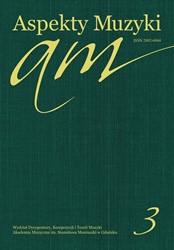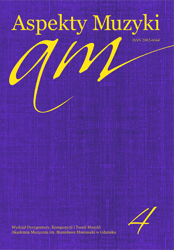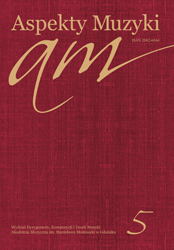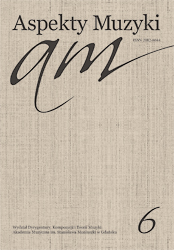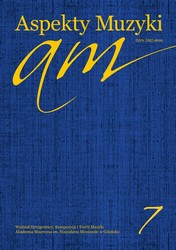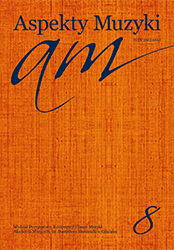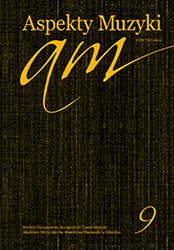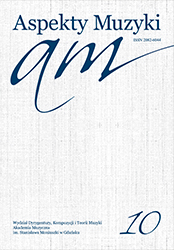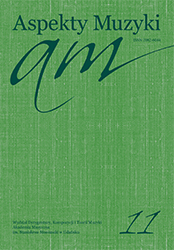ASPECTS of MUSIC, Vol. 13 (2023)
Encounters with the Orient in Music
Edited by Renata Skupin
ISSN 2082-6044
ISSN (Online) 2956-3410
ISBN 978-83-64615-92-4
DOI: 10.34861/aspmuz13
Editor-in-chief – Renata Skupin
Copy editing and English proofreading – John Comber
Editing of musical examples – Piotr Jędrzejczyk
Graphic design – Jan Misiek
Digital typesetting – zajder.pl — PRO POLIGRAFIA
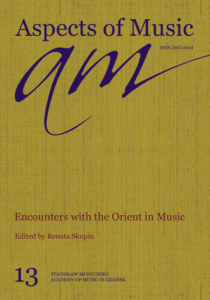
REVIEWERS / RECENZENCI
Mervyn Cooke, Professor of Music, University of Nottingham, UK
Ralph P. Locke, Professor Emeritus of Musicology, Eastman School of Music, University of Rochester, New York, USA
Derek B. Scott, Emeritus Professor of Music, University of Leeds, UK
Anthony Shepard, Professor of Music, Williams College, Williamstown, Massachusetts USA
RENATA SKUPIN
From the editor / od redakcji
ARTICLES/ARTYKUŁY
RALPH P. LOCKE
Aida i dziewięć interpretacji imperium
DOI: 10.34861/aspmuz13-04_egz-ori-aida
JONATHAN DAVID LITTLE
Oriental Colour in Exoticist Portrayals in Art and Music at the Climax of the Long Nineteenth Century
DOI: 10.34861/aspmuz13-01_ori-conc-colour
FARAH DHIB
Melismas at the Service of the Ancient Middle Eastern Libretto: An Exploration of the Opera Kanaan by Patrick Lama, Based on the Myth of Baal
DOI: 10.34861/aspmuz12-08_did-szyman
REPORTS / SPRAWOZDANIA
AGATA KRAWCZYK
From HarMA+ to HarMA HUB – The New Erasmus+ Project, Supporting the Professional Development of Music Theory Teaching Staff
DOI: 10.34861/aspmuz13-05_harma-hub-repos
This article explores how the correlation of Orientalism with “colour” helped stimulate the increasing brilliance of orchestral music as the nineteenth century approached its zenith, explaining particular analogies that were drawn between fine art and music, while emphasising the importance of colour as traced in the evolution of treatises on instrumentation and orchestration and the ever– growing focus on colour in music generally (tone / tone colour / colouration / tone painting). It also draws parallels with developments in other art forms during the period – in literature, but especially in relation to those theories revolutionising fine art – aiming to illustrate that they were all driven and underpinned by similar “Eastern”–derived aesthetic philosophies, approaches and ideals – by tending to prioritise the enrichment of colour over all other constructional parameters. Even before the turn of the twentieth century, some critics feared that such unrestrained striving after colouristic effects, or “sensationalism”, was inducing every art form to turn “decadent”.
KEYWORDS: Orientalism, exoticism, romanticism, colour, Impressionism, aestheticism, instrumentation, orchestration, programme music
The opera Kanaan (2000) by Patrick Lama, the first Palestinian opera, blends an Arabic libretto with contemporary music styles including atonality, tonality and modality. Premiered at Ruhr Festival in Recklinghausen, Germany, the opera is inspired by the Baal myth from ancient Ugaritic texts. Kanaan comprises two parts, but the article focuses on the first part, ‘The Construction of the Palace of Baal’. Born in Jerusalem, Lama was exposed to liturgical music at an early age and is influenced by various cultures. Consequently, he developed a unique style incorporating melismas – vocal embellishments stretching syllables across multiple notes. In Kanaan, melismas play a critical role in evoking Middle Eastern mythology, symbolising fertility and spirituality, and acting as leitmotivs. This article explores the aesthetic and dramatic functions of those melismas, highlighting their contribution to the opera’s richness and emotional depth. Lama’s melismatic technique, rooted in both Arabic and Western traditions, underscores the characters’ psychological dimensions and enhances the narrative’s cyclical themes of life and death. The uniqueness of Kanaan lies in Lama’s skilful integration of these musical elements, creating distinctive and profound artistic expression.
KEY WORDS: Patrick Lama, Kanaan, Baal myth, melismas, Arabic libretto, contemporary music, Palestinian opera.
Pozostałe tomy
Treść publikacji jest dostępna na licencji Creative Commons Uznanie autorstwa - Użycie niekomercyjne - Bez utworów zależnych 4.0 Międzynarodowe. Tekst licencji można znaleźć pod adresem: http:// creativecommons.org/licenses/by-nc-nd/4.0/ lub uzyskać drogą korespondencyjną od: Creative Commons, PO Box 1866, Mountain View, CA, 94042, USA.








